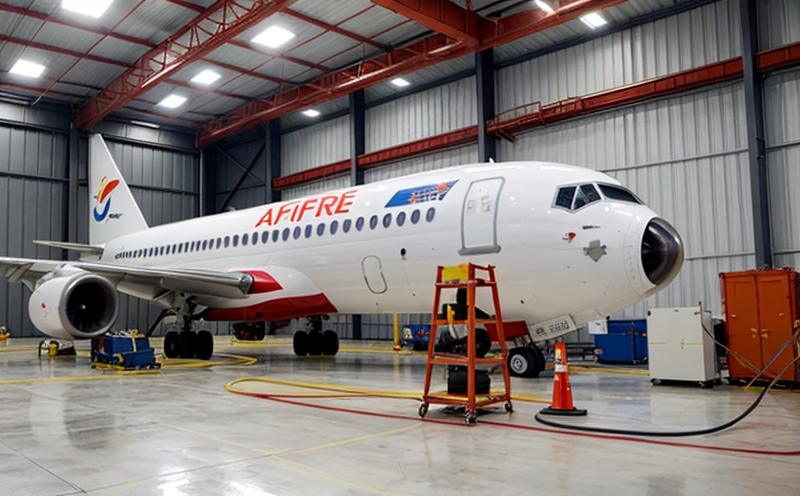Heat Release and Flame Spread Testing for Aerospace Interiors
In the aerospace industry, ensuring that interiors are safe in case of a fire is paramount. Heat release and flame spread testing play a critical role in this safety assurance process. This test assesses how much heat and smoke an interior material releases when exposed to a flame, and how quickly it spreads. The results of these tests help manufacturers identify materials that meet stringent aerospace standards for fire safety.
The primary focus of this service is the testing of materials used in aircraft interiors such as seating, flooring, ceiling panels, and other components. These tests are crucial because they evaluate not only the material's flammability but also its ability to contribute to smoke production and heat release in a fire scenario. The aerospace industry is highly regulated, and meeting these standards ensures compliance with international safety regulations.
The testing process involves placing a specified specimen under controlled conditions that mimic real-world fire scenarios. The apparatus used for this purpose includes furnaces and other specialized equipment designed to simulate the environment of an aircraft cabin during a fire. The heat release is measured in Watts per square meter (W/m²), while flame spread is rated using standardized scales like the UL 723 or NFPA 470.
After testing, the results are compiled into detailed reports that include all relevant data such as peak heat release rate, total energy released, and time to reach maximum heat release. These reports serve as essential documentation for compliance with aviation standards like those outlined in ISO, ASTM, and FAA regulations. Compliance is not only about meeting legal requirements but also about enhancing passenger safety.
The aerospace industry's fire safety testing must be rigorous due to the enclosed nature of aircraft interiors. Fire can spread rapidly within an aircraft cabin, and even a small fire could have significant consequences. Therefore, materials used in these environments are subjected to comprehensive evaluations ensuring they meet or exceed the required standards. This service is indispensable for manufacturers looking to ensure their products not only comply with regulations but also provide passengers with the safest possible environment.
The testing process involves detailed specimen preparation and adherence to strict protocols. The specimens must be cut into precise dimensions, dried under controlled conditions, and preconditioned before being placed in the test apparatus. This ensures that all measurements are accurate and comparable across different samples. The results of these tests provide critical insights into the behavior of materials under fire exposure, helping engineers make informed decisions about material selection for future aircraft designs.
Accurate testing is essential to ensure the integrity of the data used in making important safety determinations. Any deviation from standard procedures could lead to incorrect conclusions and potentially dangerous outcomes. Therefore, it's crucial that all tests are conducted using certified equipment operated by trained personnel following established protocols. The goal is to achieve consistent results that can be relied upon when making decisions about material specifications.
Understanding the implications of these tests for passengers' safety highlights their importance in the aerospace industry. By investing time and resources into thorough heat release and flame spread testing, manufacturers contribute significantly to enhancing air travel safety standards. This service is an integral part of ensuring that every aspect of aircraft interiors meets rigorous fire safety requirements.
Why It Matters
The importance of heat release and flame spread testing in aerospace cannot be overstated. These tests are crucial for several reasons:
- Enhanced Safety: By evaluating the flammability and smoke production characteristics of materials used in aircraft interiors, these tests help ensure that passengers are protected from the risks associated with fire.
- Regulatory Compliance: Aerospace manufacturers must adhere to strict safety regulations. Testing helps them meet these standards, ensuring compliance with international guidelines like ISO, ASTM, and FAA regulations.
- Risk Mitigation: The results of heat release and flame spread tests provide valuable insights into the potential hazards posed by different materials. This information allows manufacturers to make informed decisions that minimize risks.
In essence, these tests are vital for ensuring that the interiors of aircraft are as safe as possible in case of a fire. By conducting thorough evaluations and adhering to rigorous standards, aerospace manufacturers can significantly enhance passenger safety.
Industry Applications
- Aircraft Seating: Testing seating materials ensures they meet flammability requirements while also providing comfort and durability.
- Flooring Materials: Evaluating flooring ensures it is resistant to fire, maintains its integrity during a fire event, and contributes minimally to smoke production.
- Ceiling Panels: Assessing ceiling panels helps confirm they are safe in the event of fire and do not compromise cabin safety.
- In-Flight Entertainment Systems: Testing these systems ensures they withstand fire exposure without contributing significantly to smoke or heat release.
Why Choose This Test
Selecting the right test for heat release and flame spread is crucial for aerospace manufacturers. Here are several reasons why this particular service should be chosen:
- Comprehensive Evaluation: This testing provides a holistic view of how materials behave in fire scenarios, evaluating both flammability and smoke production.
- Reproducibility: The standardized procedures ensure that results are consistent across different samples and laboratories, enhancing reliability.
- Expertise: By choosing this service, manufacturers gain access to expert knowledge and experience in conducting these tests accurately.
- Regulatory Compliance: Meeting international standards like ISO, ASTM, and FAA regulations ensures that products are safe for use in the aerospace industry.
The comprehensive nature of this testing makes it an indispensable tool for manufacturers aiming to produce safe and compliant aircraft interiors. The expertise provided by experienced laboratories guarantees accurate results and reliable data.





